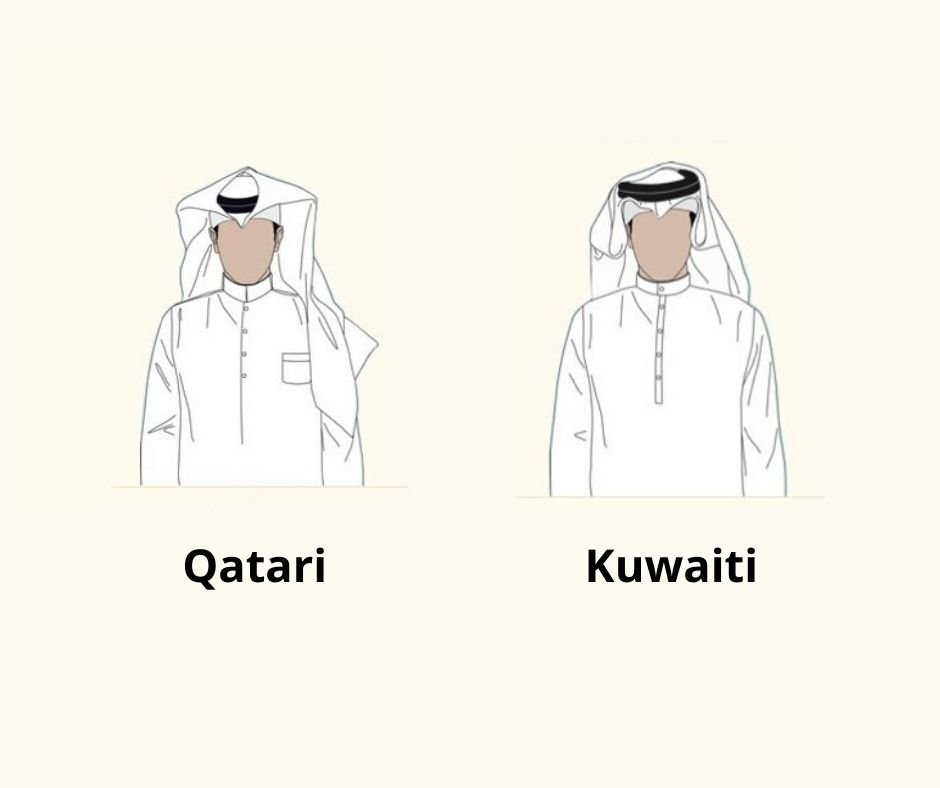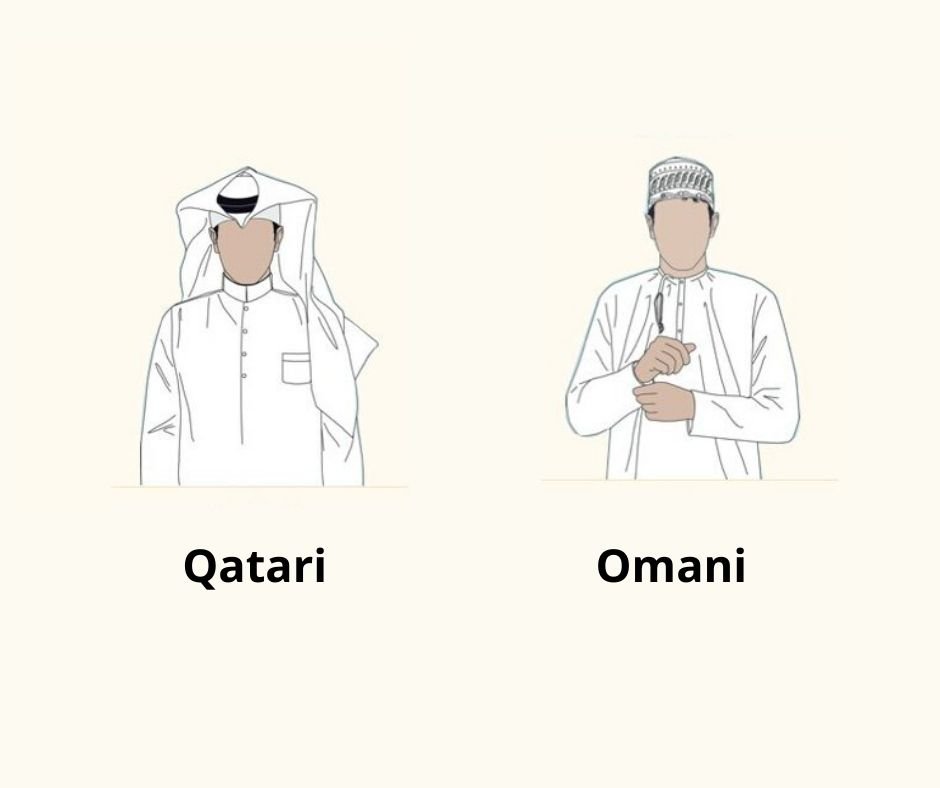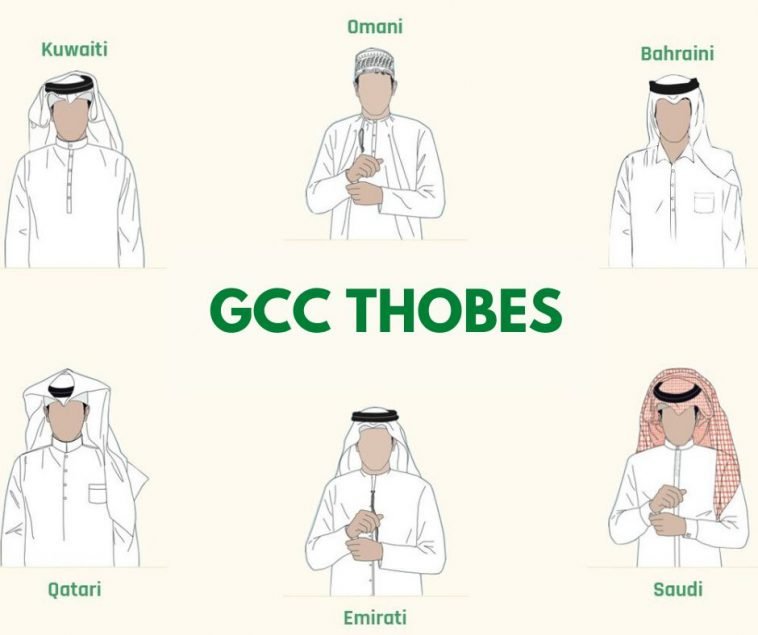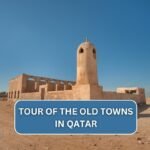Are you in GCC states (Gulf Cooperation Council), if you have recently forced yourself into a country that shows different Gulf social communities and not just the country you are in.
The Gulf Countries join Qatar, Oman, Saudi Arabia, United Arab Emirates, Bahrain and Kuwait. In these countries, if you visit the parks or shopping malls. You’ll find men with dressed beats that are not exactly equal to each person.
If you are living in any Gulf country, you will understand that the thobe styles of all Gulf countries are somewhat not equal to each other. You can perceive the nationality of a country with this thobe style.
Qatari:
The Qatari thobe is actually known for its simplicity and elegance, and it is made of lightweight and breathable material. It typically has a buttoned collar and a loose-fitting design, with no pockets or tassels.
As for the headwear, the traditional Qatari headdress is called “ghutra” or “keffiyeh,” and it is usually made of cotton or silk. It is draped over the head and held in place by an agal, which is a black cord. The agal is a symbol of strength and resilience, and it is traditionally worn by Bedouins to keep the ghutra in place during windy weather.
There is also a variation of the Qatari thobe known as the “thobe al-nashal,” which features a longer tassel or a decorative embroidery at the neck. However, this is not a common style and is mostly worn for special occasions or by older generations.
Bahraini:

The Bahraini Kanduras are known for their soft shirt collar-like design, which makes them comfortable to wear. Some styles even feature shirt-like pockets.
The headwear, known as “Gahfiya” or “Ghutra”, is typically white and made of cotton or polyester. It is often worn with an “Agal”, a black rope-like band that holds the Gahfiya in place. This traditional headwear provides a simple and stylish look and allows for free movement of the neck, unlike some other headwear styles.
Kuwaiti:

The Kuwaiti thobe, also known as Kuwaiti Kanduras, is distinctive for its excellent use of high-quality fabric and attention to fit. The collar of the thobe features a button, adding an extra touch of style.
The headwear, called “Ghutra” in Kuwait, is made by taking the gotra at uneven lengths, dropping it over the shoulders and finishing over the head. The shape of the Ghutra resembles that of a scale when seen from the front, giving it a unique and elegant appearance.
Kuwaiti Kanduras are usually worn in lighter colors during the summer months, while darker shades are preferred during the winter. The traditional embroidery on the thobe is done in silver and gold threads, adding an extra touch of luxury to the garment.
Omani:

Omani Kanduras, also known as dishdashas, are traditional garments worn by Omani men. Unlike the Emirati and Saudi thobes, Omani kanduras do not have a collar and are typically buttoned just over the chest. They are often made of lightweight materials such as cotton or linen to suit Oman’s hot and humid climate.
Omani kanduras also feature unique and colorful embroidery designs on the cuffs and neckline, making them stand out from other traditional garments in the region. The embroidery is often intricate and symbolic, representing Omani culture and heritage.
The headwear worn with Omani kanduras is called a Mussar, which is different from the headwear worn in other GCC countries. Mussars are typically made of cotton or wool and come in a variety of colors and patterns. They are wrapped around the head and secured in place with a cap or turban.
Omani men take great pride in their traditional attire and often wear it for formal occasions such as weddings and religious ceremonies. The kandura and Mussar are not only functional, but also serve as a symbol of Omani identity and cultural heritage.
Saudi:

The Saudi Thobe is a traditional garment worn by men in Saudi Arabia. It is similar to the Emirati Thobe, but has some distinct differences. The Saudi Thobe is typically more form-fitting than the Emirati Thobe, with a narrower cut and a tighter collar that has three buttons. The sleeves of the Saudi Thobe are usually shorter than the Emirati Thobe, and require cufflinks for a proper fit.
The headwear worn with the Saudi Thobe is called a ghutra, which is a square-shaped scarf made of cotton or wool, and is usually worn folded in a triangular shape and held in place by an agal, a black cord that is draped over the top of the head. Another traditional headwear worn by Saudis is called the bint al-bakar, which is a type of headdress made of two pieces of cloth that are wrapped around the head to form a turban-like shape. The bint al-bakar is typically worn during special occasions or by older men.
One interesting aspect of the Saudi Thobe is the question of what men wear underneath it. While some men may wear Western-style clothing, others prefer to wear traditional undergarments such as a white cotton shirt and trousers. There is also a custom of wearing a decorative belt with the Thobe, which adds a touch of elegance and style to the overall look.
Emirati:
The Emirati thobe is a traditional ankle-length dress worn by Emirati men. It is typically made of lightweight cotton or wool fabric in white or light-colored shades, with long sleeves and a high collar. The thobe is loose-fitting, allowing for air to circulate and keep the wearer cool in the hot desert climate.
The thobe is often worn for formal occasions such as weddings, religious events, and national celebrations. It is a symbol of Emirati heritage and cultural identity, and its design has remained largely unchanged for centuries.
Emirati men often wear a headscarf or ghutra with the thobe, which is folded and draped over the head and shoulders. The ghutra is held in place with an agal, a black cord that is wound around the head.
The thobe is also often adorned with intricate embroidery, particularly on the collar and cuffs. This embroidery is usually done in gold or silver thread, and can feature geometric patterns or intricate floral designs.
Please Subscribe Us to get updated with Qatar News, Saudi News, Kuwait News, Health News, UAE News, Iqama, Visa, Jobs, Banking and More.



